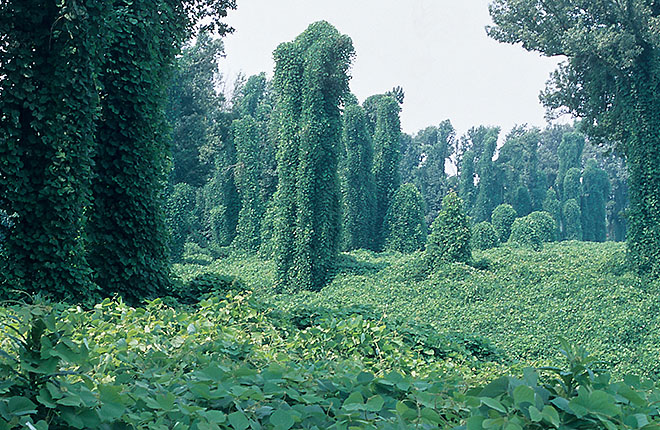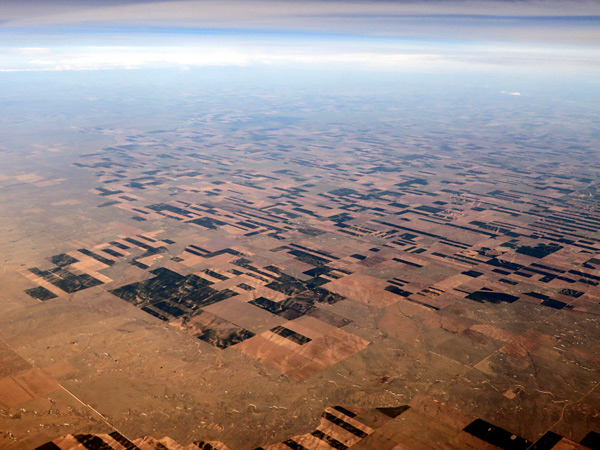Kudzu: “The Vine That Ate the South”
by Edward Ulrich, September 28, 2022

Kudzu is a vine that can overtake entire forests if left unchecked. Image from the USDA.
The “Kudzu” plant is a vine that grows at an extraordinary rate of almost a foot a day. It was imported into the U.S. from Japan in the late 1800’s, where it has since turned into an invasive species, becoming known as “The vine that ate the South.”
Growing Kudzu became popular in the U.S. in the early 1900’s for feeding livestock, and it was often planted on roadsides to stop erosion, where it then spread into adjacent forests. The plant started falling out of favor in the 1950’s when people started to notice that it was growing in an out of control manner.
The plant has amazing characteristics that are very beneficial when it is planted as a crop, but now it is often taboo or even illegal to grow it in some areas due to the issues caused by how it was previously planted.
Kudzu spreads by its vines taking root where they make contact with the ground, where they then grow as their own plant, and it also creates flowers and seeds. It is a member of the legume family as soybeans are, and it is a “nitrogen-fixing” plant that means it fertilizes the soil as it grows.
This article explains the benefits of growing kudzu as a crop, and why it is ideal for making organic compost.
Growing Kudzu as a crop
Kudzu is very effective to grow as a crop. For example it is ideal to feed humanely raised livestock, and it is also a great source of biomass that can be used for creating organic compost since it grows so quickly. Once kudzu is established in a field it does not need to be re-planted, even after many years.
Of course is it important to not have Kudzu growing where it is not wanted, therefore it makes sense for its cultivation to be regulated where necessary, perhaps by specifying that a buffer zone exists around fields where it is grown.
Certain areas of the U.S. are better suited for cultivating the plant than others, for example areas of the Midwest that do not have trees would have no issues when growing it.

Kudzu is very effective to grow as a crop. For example it is ideal to feed humanely raised livestock, and it is also a great source of biomass that can be used for creating organic compost since it grows so quickly. Once kudzu is established in a field it does not need to be re-planted, even after many years.
Of course is it important to not have Kudzu growing where it is not wanted, therefore it makes sense for its cultivation to be regulated where necessary, perhaps by specifying that a buffer zone exists around fields where it is grown.
Certain areas of the U.S. are better suited for cultivating the plant than others, for example areas of the Midwest that do not have trees would have no issues when growing it.

Areas of the midwestern U.S., such as this region of Arriba in eastern Colorado would be very suitabe for growing Kudzu. Image: Wikipedia.
Using Kudzu for creating compost
Because Kudzu grows so quickly, it can be an excellent component of organic compost, which can be used instead of chemical fertilizers that pollute rivers and have other issues.
The composting process happens when nitrogen-rich “green” materials are mixed with carbon-rich “brown” materials, which causes the mixture to naturally decompose into an nutrient-rich fertilizer that can be used to improve the quality of soil for growing plants.
When compost is in the process of being created it heats up to about 150 degrees Fahrenheit, which causes it to emit steam due to the action of microbes in the mixture. The composting process is sped up by the mixture being aerated, such as being turned at regular intervals or having air forced through the mixture.
Fresh kudzu can act as the “green” component in the compost. Other potential “green” materials are grass clippings, green leaves, and kitchen waste. A Wikipedia article refers to this component as “green waste.” Waste products are often used as this component such as kitchen scraps and lawn trimmings, however it doesn’t necessarily need to be “waste” if the goal is simply to create compost.
The “brown” component of the compost is “woody materials” that are rich in carbon such as plant stalks, wood chips, dry leaves, hay, sawdust, corn cobs, or cardboard.
An ideal compost should have 30 parts carbon to 1 part of nitrogen, but the actual proportions of the materials used can vary quite a bit depending on what is being used. This article explains that issue, saying that as a general guide it is good to start with 3-4 times as much brown material as green material, and you can adjust the proportions during the composting process to ensure the most effective mixture.
I think it is interesting that the Wikipedia article about the “brown” component of the compost lists some of the same materials as it does for the “green” one, with the only difference being the fact that the brown componens have been dried, such as dried leaves. Therefore, it seems likely that compost could be created from 100% kudzu— where green kudzu is mixed with dried kudzu. But kudzu would certainly be a very effective component of a compost in any event.
Kudzu is often used as a component of compost in the southern United States where it is plentiful. For example someone explains using it in this forum post.
The following videos show large-scale composting operations. They don’t specifically depict the use of Kudzu, but the processes would be similar if they did.
This video shows a large-scale composting operation run by the city of Franklin, Tennessee, where compost is created from leaves and yard waste that otherwise would have gone into a landfill.
Two brothers in Arkansas have built their own version of a large-scale mechanical compost mixer, saving between $10k - $18k. Such a mixer can be ordered through their Facebook page. Also see their website Abundance Plus.
John Kohler of GrowingYourGreens.com is visting “Farm Dirt Compost” in Houston, Texas, which processes large amounts of yard waste and food scraps from local schools to turn it into compost.
In the video he explains the process of composting; he talks about benefits of plant-based compost over manure-based compost; he explains how aerating the mixture speeds up the composting process; and he explains the best way to test the quality of the resulting compost.
Kolher has made many videos about organic composting, see a list of the videos at this link.





















